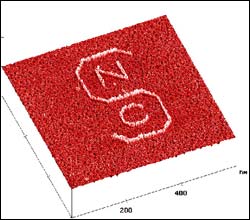Molecule by Molecule, NC State Scientists Design a New Transistor

A patterned collection of molecules <br>created and visualized using scanning tunneling microscopy like that used to help create the nanoscale transistor. <br>Data collected by R. Fuierer
When amazing new computers and other electronic devices emerge, they will have been conceived and incubated in university laboratories like that of Dr. Chris Gorman, professor of chemistry at North Carolina State University. There, the scientist and his multidisciplinary team are working to build, molecule by molecule, a nanoscale transistor.
That’s an electronic switch so small it can only be seen with a high-tech device called a scanning tunneling microscope. And if you go to the library to find the “how-to” book, says Gorman, “most of the pages will be blank, because nobody yet knows how to do it.”
And that, for the chemists, engineers and students engaged in the project, is what makes their painstaking, pioneering research so satisfying. If they can design and construct a nanoscale transistor, Gorman, his colleagues and his students will have filled in many of the blank pages in the how-to book. The field is so new, the research avenues so unexplored, that each experiment, each variation, helps write that book.
Their work is guided by the “bottom-up” approach to building something, says Gorman. “Most things are built using ‘top-down’ methods,” he explains, “where you take a chunk of metal, stone or wood and carve off the material you don’t want, until you have an I-beam or a two-by-four. In contrast, we’re interested in assembling molecules, and building a functioning transistor – with as few of the molecules as possible.”
A persuasive advocate of multidisciplinary research, Gorman is working with NC State colleagues Dr. Daniel L. Feldheim, associate professor of chemistry, and Dr. Gregory N. Parsons, associate professor of chemical engineering, to combine this bottom-up approach with Parsons’ top-down engineering in the creation of the nanoscale transistor. Parsons will construct a molecular platform with a tiny indentation into which Gorman, Feldheim and their student team hope to fit a molecular “plug.” The resulting structure should function as an electronic switch – the definition of a transistor.
“Our research will tackle two critical issues in future materials for advanced molecule-based information processing,” says Gorman. “One, how to assemble and attach single molecules to electronic contacts and, two, how to create electronic gain – the fundamental operating principle of a transistor – at the molecular level.”
The benefits of the team’s success could be far ranging, he says. “Better techniques for information processing will keep our economy growing stronger by enabling smaller, faster and lighter electronics.” Imagine, says Gorman, the contents of a library in a postage-stamp-sized chip, and you can begin to ponder some exciting possibilities and “the next phase of electronics development in the United States.”
While the private sector and corporate research and development will ultimately develop such technologies, Gorman says, the fundamental research – with its exploration of byways and promising side streets, false starts as well as serendipitous discoveries – must take place in universities, with federal and state help.
Gorman’s research, for example, is funded by the National Science Foundation through its Nanoscale Interdisciplinary Research Teams (NIRT) program.
Another must, according to Gorman, “is fundamentally changing how the next generation of technically savvy students is educated. In our research, we want our students to pursue degrees that involve traditional science, engineering and technology-development aspects and state-of-the-art research approaches. We also want to expand the opportunities for women and minorities to participate in this new, interdisciplinary paradigm.”
As evidence that this new paradigm is already taking shape, Gorman’s undergraduate and graduate students, “the Gorman Group,” are fully engaged in his quest for the nanoscale transistor. From the newest students, such as Tiffani Bailey and Jennifer Ayres, to rising juniors such as Bill Capshaw and Jonah Jurss, to veteran grad students such as Tyson Chasse and Drew Wassel, among others, the group collaborates in exploring the nanoscale realms for promising applications.
“With the increasingly fast pace of technological change,” says Gorman, “it’s possible that many of the rules that we teach students in college can be obsolete by the time they graduate. That’s why we must focus on how to think, how to solve problems, how to explore the unexpected avenues and surprising new paths – and, in some ways, to disregard traditional disciplinary boundaries.”
Disregarding traditional boundaries may be a necessary practice for all successful scientists, especially the pioneers, such as Gorman, working at the very edge of the possible. When the next generation of technology transforms our lives, it will have been conceived and perfected in university labs, built grant by grant, student by student, molecule by molecule.
Media Contact
More Information:
http://www.ncsu.edu/news/press_releases/03_11/337.htmAll latest news from the category: Interdisciplinary Research
News and developments from the field of interdisciplinary research.
Among other topics, you can find stimulating reports and articles related to microsystems, emotions research, futures research and stratospheric research.
Newest articles

Witness Groundbreaking Research on Achilles Tendon Recovery
Achilles tendon injuries are common but challenging to monitor during recovery due to the limitations of current imaging techniques. Researchers, led by Associate Professor Zeng Nan from the International Graduate…

Why Prevention Is Better Than Cure—A Novel Approach to Infectious Disease Outbreaks
Researchers have come up with a new way to identify more infectious variants of viruses or bacteria that start spreading in humans – including those causing flu, COVID, whooping cough…

Durable, Efficient, Sustainable: The Rise of Cerium Oxide Thermal Switches
Groundbreaking cerium oxide-based thermal switches achieve remarkable performance, transforming heat flow control with sustainable and efficient technology. Cerium Oxide-Based Thermal Switches Revolutionize Heat Flow Control Thermal switches, which electrically control…



